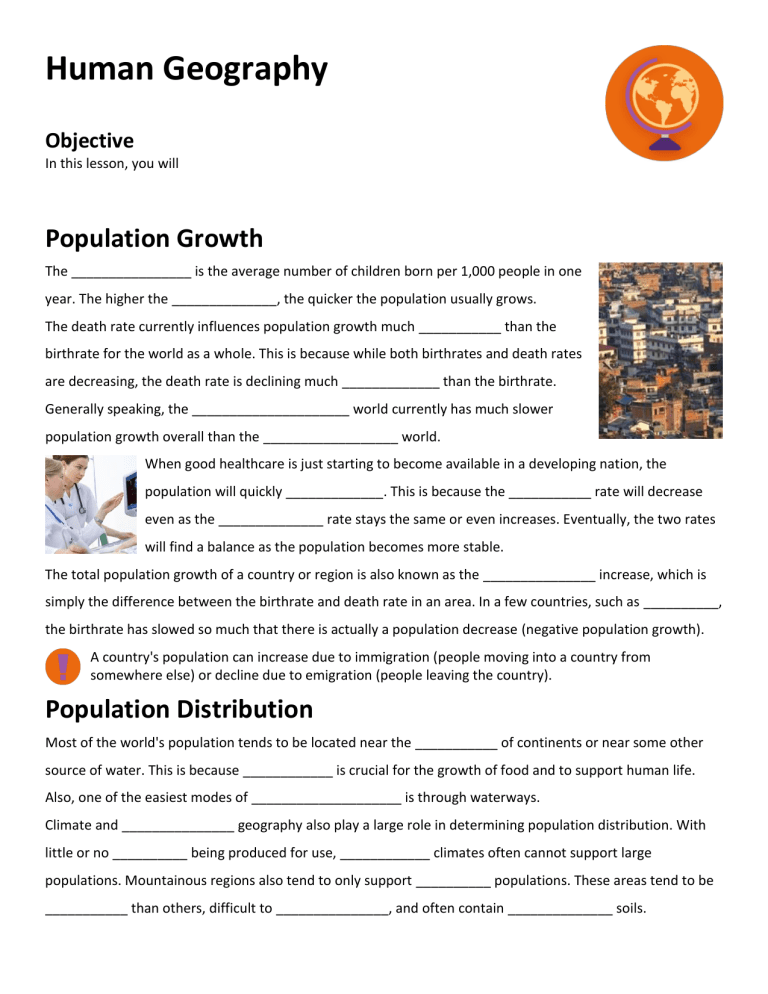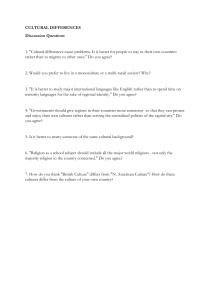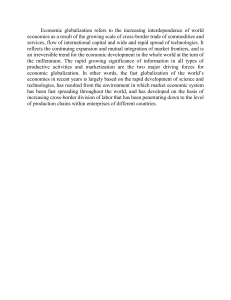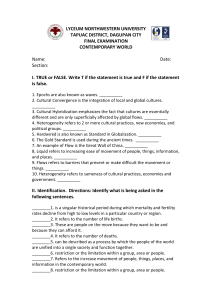
Human Geography Objective In this lesson, you will Population Growth The ________________ is the average number of children born per 1,000 people in one year. The higher the ______________, the quicker the population usually grows. The death rate currently influences population growth much ___________ than the birthrate for the world as a whole. This is because while both birthrates and death rates are decreasing, the death rate is declining much _____________ than the birthrate. Generally speaking, the _____________________ world currently has much slower population growth overall than the __________________ world. When good healthcare is just starting to become available in a developing nation, the population will quickly _____________. This is because the ___________ rate will decrease even as the ______________ rate stays the same or even increases. Eventually, the two rates will find a balance as the population becomes more stable. The total population growth of a country or region is also known as the _______________ increase, which is simply the difference between the birthrate and death rate in an area. In a few countries, such as __________, the birthrate has slowed so much that there is actually a population decrease (negative population growth). A country's population can increase due to immigration (people moving into a country from somewhere else) or decline due to emigration (people leaving the country). Population Distribution Most of the world's population tends to be located near the ___________ of continents or near some other source of water. This is because ____________ is crucial for the growth of food and to support human life. Also, one of the easiest modes of ____________________ is through waterways. Climate and _______________ geography also play a large role in determining population distribution. With little or no __________ being produced for use, ____________ climates often cannot support large populations. Mountainous regions also tend to only support __________ populations. These areas tend to be ___________ than others, difficult to _______________, and often contain ______________ soils. The average number of people who live within a certain area is known as the population ___________. Cities tend to have ____________ population _______________ then other areas. Europe is the _______ densely populated continent but does not have the highest total population. ________ is the continent with the most people. It has more than 60% of the world's population. Introduction to Culture Culture refers to the similar ____________ and _____________ that groups of people share. This can include _________________, _____________, governmental system, or any other common belief and custom. Language Langauage ______________ are large groups of languages with common roots. Today, the Indo-_____________ and Sino-____________ language families are the most widely spoken across the globe. Indo-_____________ languages owe a large part of their success to the migration of those who spoke them. _____________ is a small country that has a disproportionate number of people who speak its language globally. This is mostly because England ________________ so many lands, including the United States. It is also because England and its former colonies were among the first to become __________________. Sino-Tibetan languages are widely spoken as a result of total population numbers where they originated. Since Mandarin Chinese, a language within the Sino-Tibetan family, is the dominant language of China and China has the world's largest population, It is the most widely spoken language on the planet. Religion Beliefs affect many aspects of a region's culture, including __________ values, ___________, architecture, music, dances, and ____________. The religions with the most followers globally are Christianity, Islam, _______________, and Buddhism. ➢ Christianity and __________ have had the most success becoming ___________________ religions. ➢ _____________ has become the most practiced religion of the Middle East region, as well as much of North Africa. It is also very popular in Indonesia and other parts of South Asia There are often limited sects within each religion that practice ____________________. This movement has largely been a reaction to the global spread of culture in recent years. Fundamentalists are those who follow a certain set of established rules or principles, such as those described in the ___________ (Christianity) or the _______________ (Islam). They follow a ______________ interpretation of these books. In following these teachings, many fundamentalists reject various _____________ ideas and technologies. Social Groups Different social groups exist in every society on Earth. Sometimes they are based on level of ______________, ancestry, or ____________. An _________ group is composed of people who share a more specific set of traits than the culture at large. These traits may include ancestry, _______________, or place of origin. The smallest social group in all cultures is the _________ unit. Historic Developments in Culture Many historians analyze the cultures (and cultural hearths) of ancient civilizations to make connections with cultures that exist today. It is generally agreed upon that there were _________ early cultural hearths. The first evidence of a developed civilization has been found in an area referred to as Mesopotamia. Also known as the __________ ______________, Mesopotamia has ___________ soil in an otherwise arid region. Most cultural hearths were located around a major source of __________, such as a river. This is because the invention of _________________ allowed early people to develop permanent settlements. These settlements allowed people to begin to feel that they belonged to a certain geographic location. This caused the territories of a particular civilization to have definite boundaries. Each hearth developed its own type of religion. Most of these early religions were _______________, believing in spirits outside of the ____________ ________. Many of these were also polytheistic, believing in many gods. Of the major religions that exist today, Islam, Judaism, and ______________ are monotheistic, while Hinduism is _________________, meaning Hindus worship various aspects of the same god. The first ________ were created during the existence of these early cultural hearths, as well. Many of these early cultures also developed a complex understanding of _______________ and mathematics. In modern times, perhaps the most influential factor in shaping culture has been the ________________ _____________________. Instead of working on the family ________, people began working for an hourly wage at a _____________. They also lived in ___________ instead of the country. The rapid increase in the population of cities caused many problems, such as _____________________ and ____________________. Culture and Environment Factors like _____________, physical geography, and ___________ availability all play a role in determining an area's culture. They do this by affecting the food supply, _____________________, contact with the outside world, and perhaps most importantly, the ___________________ _______________. Government Type of Government Basic Characteristics Monarchy a monarch makes decision for the country; power is passed on hereditarily Oligarchy rule by a __________ group of people, usually from the ___________ class Dictatorship one leader rules with aboslute power; leader usually seizes power by force Communism government controls the economy by taking charge of resources and production Democracy government in which people ___________ on issues and leaders Theocracy _____________ and ________________leaders dictate how the country will run Republic government type in which people ___________ representatives Often these types of governments are combined in a given country. Economic Systems Type of Economic System Traditional Basic Characteristics _____________ dictate economic decisions The government ___________ or directs the means of production (land, labor, Command capital) A country’s wealth and production is _____________ by the government and then redistributed to its citizens Private companies and individuals make decisions about what to produce Market Consumers have ________ choices on what to purchase Limited government ________________________ with the economy Individuals and businesses strive to make a ________________ Traditional economies are _________ throughout the world today. They exist mainly in _________ or sparsely populated areas where daily life has changed little over many generations. The countries with the purest command economies have a ______________ style of government that limits the freedoms of its people. A present day example of this type of economy exists in North Korea. There, all business and factories are _______-owned. Market economies also exist in various forms throughout the world. The purest forms of these economies allow ______________ to operate without any _______________ or government interference. Most of the time governments adopt a __________ economy that is balanced between ____________ and command principles. Globalization Globalization is the general spread of ideas and customs around the world. Globalization: Economics Most economies in the world cannot produce everything that they need and want within their borders for the lowest price. For this reason, _________ has developed and grown across the world for thousands of years. Globalization: Culture People have been increasingly exposed to outside cultures and adopted some outside influences. These include the spread of ______ and ______________, and also include the spread of sports or TV shows. Perhaps the most significant influence on global culture in the past 20 years has been the _______________. Summary What are some examples of social groups? What common trait do the members of each group share that distinguishes them from the larger group?




